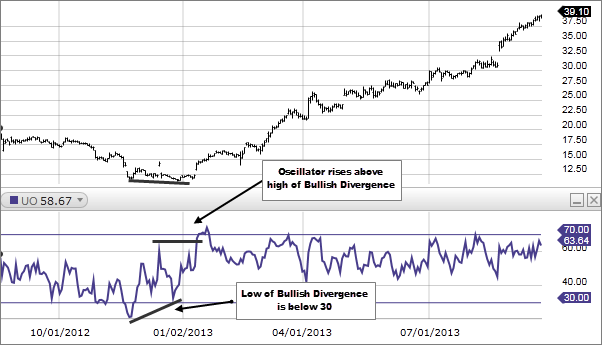Description
Many momentum oscillators use one time frame which causes them to turn very positive at the beginning of a major advance and then form a bearish divergence and overbought readings while the advance continues. The Ultimate Oscillator, developed by Larry Williams, attempts to correct this by using three different time periods (7, 14, and 28) to represent short, medium, and long-term market trends.
Buy Signal:
- A bullish divergence occurs. This is when the security's price makes a lower low that is not confirmed by a lower low in the Oscillator.
- During the bullish divergence, the low of the Oscillator falls below 30.
- The Oscillator then rises above the highest point reached during the span of the bullish divergence.

Sell signal:
- A bearish divergence occurs. This is when the security's price makes a higher high that is not confirmed by a higher high in the Oscillator.
- During the bearish divergence, the high of the Oscillator rises above 70.
- The Oscillator then falls below the lowest point reached during the span of the bearish divergence.

Buying Pressure (BP) = Current Close – Minimum (Current Low or Previous Close).
True Range (TR) = Maximum (Current High or Previous Close) – Minimum (Current Low or Previous Close)
Average7 = Sum of BP for the past 7 days / Sum of TR for the past 7 days Average14 = Sum of BP for the past 14 days / Sum of TR for the past 14 days Average28 = Sum of BP for the past 28 days / Sum of TR for the past 28 days
Ultimate Oscillator = 100 * [(4 * Average7) + (2 * Average14) + Average28] / (4 + 2 + 1)
